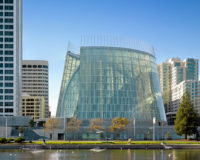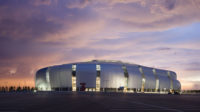Boston, Massachusetts
In recent years the design of hospitals that emulate hotels has generated a warming trend in this often forbiddingly cold, institutional building type. Evidence-based design, stemming from scientific studies that show patients get better faster in settings with daylight, views, plants, and physical and acoustical privacy, gave impetus to this revolution (record, August 2009, page 73). It usually helps if the hospital occupies a significant slice of nature, with vistas of trees, other vegetation, and water. But some hospitals, such as Massachusetts General Hospital (MGH) in Boston, have created a noninstitutional environment on an existing, dense campus downtown.
On the tight 42,000-square-foot site, the architects inserted a glass and steel-framed squarish polygonal volume on the west side of the arrivals court to MGH's main entrance. To mitigate its hulking presence, NBBJ fragmented the massing and angled exterior planes, in addition to detailing the glass facade, to express the building's separate functions on the exterior. While clear glass sheathes the first two floors (devoted to reception, emergency admissions, and circulation), vertical fritted glass fins on the third and fourth floors (dedicated to procedural services) allow daylight to enter the interior while affording occupants a sense of privacy. Above, on the fifth level, a solid wall of insulated metal panels, covered in wire mesh, masks a double-height mechanical space. For the patient-room portion, from the sixth to 10th floors, the architects emphasized the horizontal lines of glass curtain walls, which are broken by receding and slanted planes that follow the carved-out portions of the floor plate.
The building inflects horizontally to MGH's Yawkey Center for Outpatient Care to the south and to the vertical glass tower of the Ellison Building to the north as part of the architects' intention to seamlessly connect Lunder visually and physically to other hospital structures around it.
Connection is a major subtext: Visitors enter the new facility from the White Building, the hospital's main entrance to the north. As you come into Lunder, you find that a large stair, parallel to the glass facade, takes you to the second level, where a corridor snakes along the glass front of the building to connect Yawkey on one end with White and Ellison on the other. By placing the main circulation on the second floor, the architects linked Lunder physically to adjoining buildings, while staying within existing floor-to-ceiling heights.
In the five-story bed tower, two wedge-shaped openings cut out of the overall volume accommodate an 80-foot-high skylit atrium, as well as an open-air garden court, where bamboo trees shoot upward past the patient levels. (For more details on planting for health care at Lunder, see related story.) All rooms are single-occupancy in order to prevent the spread of infection, afford privacy and acoustical isolation for recuperation, plus accommodate the patient's family members and visitors. To give the inpatient rooms views of the outdoors yet enable nurses and doctors to reach patients quickly, NBBJ placed the rooms around the edges of the broken perimeter, and located support staff in two blocks in the center. A diagonal corridor cuts through from one corner—where the elevators stop at the atrium—to the exterior garden well opposite.
By breaking the nursing pods apart and connecting the floor with a diagonal circulation spine, NBBJ also mitigated excessive noise generated by movement and conversation in hospital halls and stations. Acoustical ceiling and wall panels and rubber floors also help alleviate unwanted sounds. And since rooms project into the corridors at an angle, their serrated configuration helps cut down on acoustic reverberation. This feature, along with ample cove lighting from reveals along the ceiling soffits, also softens the ambience visually.
Owing to typical 9-foot ceiling heights, ample windows, and views of the city, the patient rooms seem light and airy. Translucent sliding glass doors promote visual and physical access, and for extra safety, caregiver stations inside the rooms overlook patient beds and private bathrooms.
Certain treatment areas in Lunder, however, do lack daylight—specifically the radiation-oncology center in the below-grade third and fourth levels of the concrete substructure. To alleviate the sense of being so far underground, the architects designed two waiting rooms as 23-foot-high volumes; one, for reception, is illuminated by rodlike lighting fixtures suspended above the seating. Soft colors and bamboo wall panels add a residential feeling to the space.
In addition, the client and NBBJ undertook sustainable measures to meet LEED Gold certification standards. These include selecting recycled or locally obtained materials plus renewable bamboo finishes, conserving water by installing low-flow plumbing fixtures, and feeding plants with nonpotable water, rainwater, and air-cooling condensate. The architects used energy-efficient insulated glass with low-E coating throughout. For patient floors they chose glazing with a high visible-light transmittance and a high shading coefficient. In addition, NBBJ selected low-iron insulated glazing for the atrium, adding fritted glass to cut glare and heat and reduce visibility in private consultation areas.
All told, the Lunder Building seems to solve a lot of problems with ease. Although the hospital is not yet monitoring the effects of these design strategies on recovery time, the overall planning would suggest a promising bill of health, architecturally speaking. The scheme, at the least, offers health-care specialists an important laboratory in which to conduct and refine their research as befitting the 200-year-old institution.
PeopleOwner: Massachusetts General Hospital
Architect:
Personnel in architect's firm who should receive special credit:
Design Team: Associate architect: Chan Krieger Sieniewicz (now NBBJ) Interior designer: NBBJ
Engineer(s):
Consultant(s):
Photographer(s):
Frank Oudeman
Sean Airhart/NBBJ CAD system, project management, or other software used: Microstation Triforma Size: 535,000 square feet Completion date: May 2011 |
Products
Structural system
Metal Panels: Benchmark Architectural Systems, Inc., Metecno Aluma Shield Built-up roofing: Kemper (Roof Garden), GreenGrid (Roof Garden), Carlisle SynTec Incorporated Glazing
Glass: Viracon, Pilkington
Entrances: Horton Automatics, Door Concepts Incorporated, Crane Revolving Doors
Door Hardware
Glass: Oldcastle BuildingEnvelope, Bendheim, Skyline
Office furniture: Steelcase, Lista
Pinnacle Architectural Lighting
Elevators/Escalators: Delta Beckwith Elevator Company American Standard, Chicago Faucets, Zurn, Symmons, Leonard Water Temperature Controls, Just
Energy |



















Post a comment to this article
Report Abusive Comment